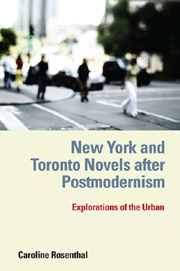Book contents
- Frontmatter
- Contents
- Preface and Acknowledgments
- Introduction
- 1 Imagining National Space: Symbolic Landscapes and National Canons
- 2 Articulating Urban Space: Spatial Politics and Difference
- 3 “The Inadequacy of Symbolic Surfaces”: Urban Space, Art, and Corporeality in Siri Hustvedt's What I Loved
- 4 Rewriting the Melting Pot: Paule Marshall's Brownstone City in The Fisher King
- 5 Specular Images: Sub/Urban Spaces and “Echoes of Art” in Carol Shields's Unless
- 6 “The End of Traceable Beginnings”: Poetics of Urban Longing and Belonging in Dionne Brand's What We All Long For
- 7 Synthesis
- Bibliography
- Index
2 - Articulating Urban Space: Spatial Politics and Difference
Published online by Cambridge University Press: 12 September 2012
- Frontmatter
- Contents
- Preface and Acknowledgments
- Introduction
- 1 Imagining National Space: Symbolic Landscapes and National Canons
- 2 Articulating Urban Space: Spatial Politics and Difference
- 3 “The Inadequacy of Symbolic Surfaces”: Urban Space, Art, and Corporeality in Siri Hustvedt's What I Loved
- 4 Rewriting the Melting Pot: Paule Marshall's Brownstone City in The Fisher King
- 5 Specular Images: Sub/Urban Spaces and “Echoes of Art” in Carol Shields's Unless
- 6 “The End of Traceable Beginnings”: Poetics of Urban Longing and Belonging in Dionne Brand's What We All Long For
- 7 Synthesis
- Bibliography
- Index
Summary
All places are already articulations, so that the migrant does not move to a pure place, but displacement occurs between contexts which are themselves already complex constructions.
— Doreen Massey, “Double Articulation: A Place in the World”THE PREVIOUS CHAPTER GAVE a historical overview of how the United States and Canada, respectively, have semioticized space. It looked at how representations of symbolic spaces became the dominant spatial narratives of each nation in processes of canon formation and focused especially on the function of nature-culture paradigms for the literary self-conceptualization of the United States and Canada. My concluding argument was that while in the past the city did not loom large in the Canadian imagination, due to factors of literary history — the lack of a strong pastoral tradition, for instance — and to sociocultural aspects — the overwhelming presence of city images emanating from Great Britain and the United States, for instance — the city is gaining ground in the literary imagination of Canada in our days. This is happening at a time in which general conceptualizations of space have drastically changed and in which both urban space and urban fiction are being reassessed. American urban fiction is firmly grounded in the aesthetic traditions of modernism and postmodernism and is grappling with those legacies while trying to find ways to represent the city in new terms. Contemporary Canadian urban fiction, on the other hand, still deals with questions of national self-conceptualization and of defining the “here.” What North American urban fiction shares these days is that it contributes to making and reflecting the multicultural metropolis and investigates the complex ways in which individual and collective, private and public positions and spheres overlap in the city.
- Type
- Chapter
- Information
- New York and Toronto Novels after PostmodernismExplorations of the Urban, pp. 49 - 72Publisher: Boydell & BrewerPrint publication year: 2011



